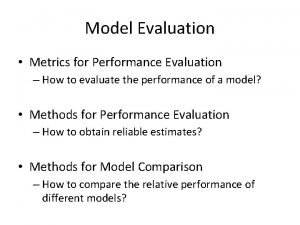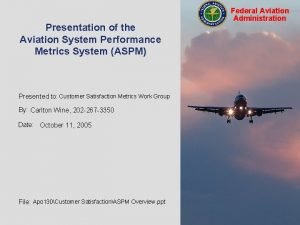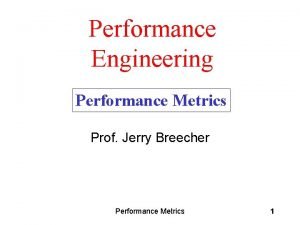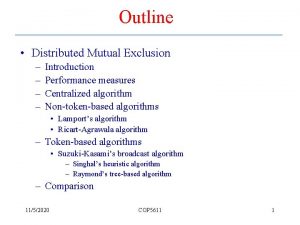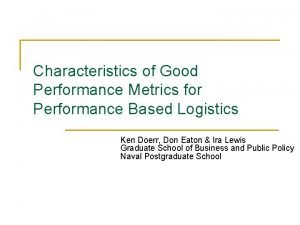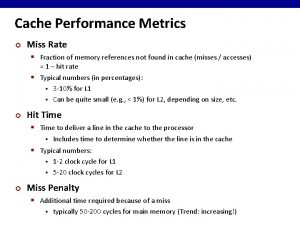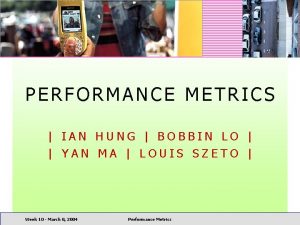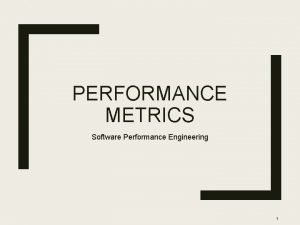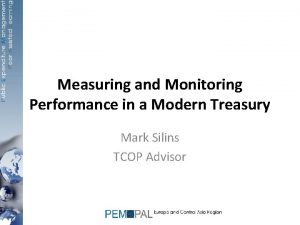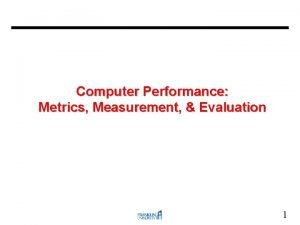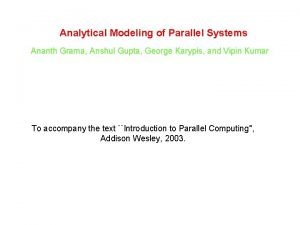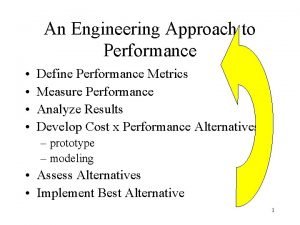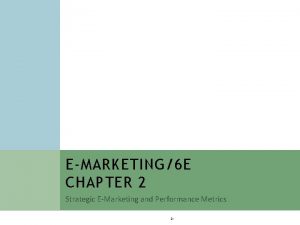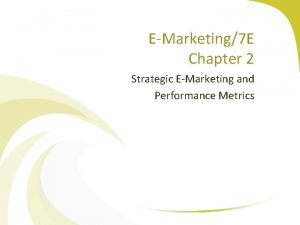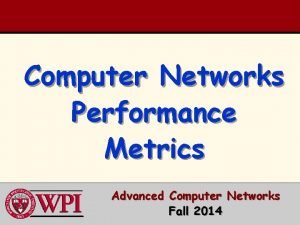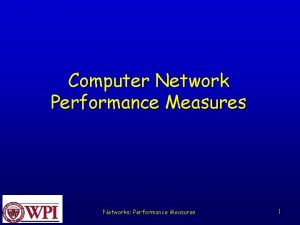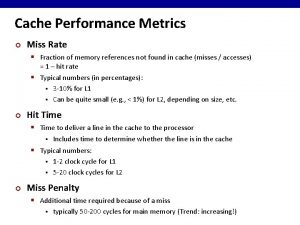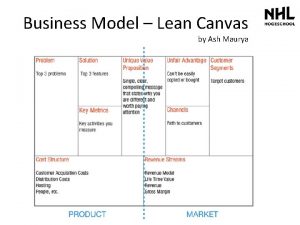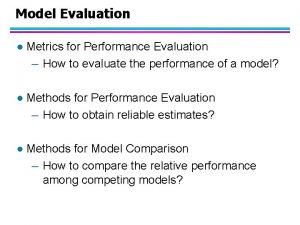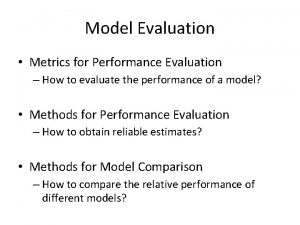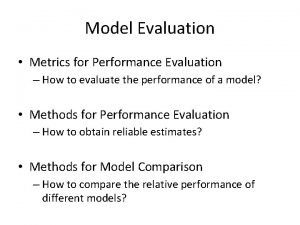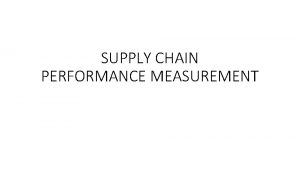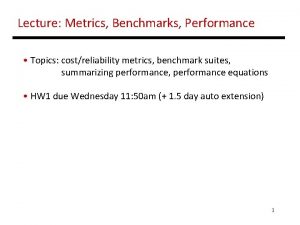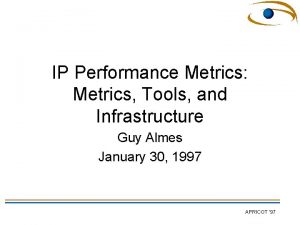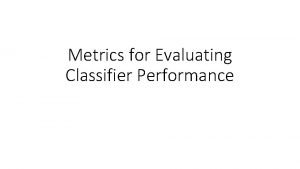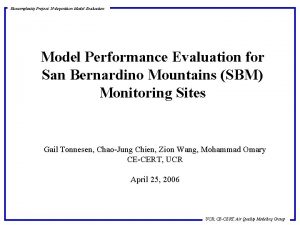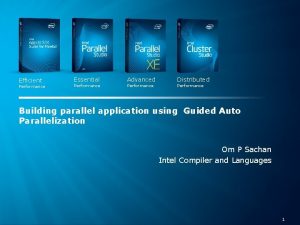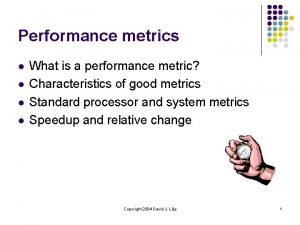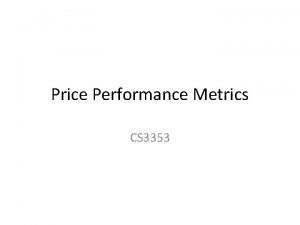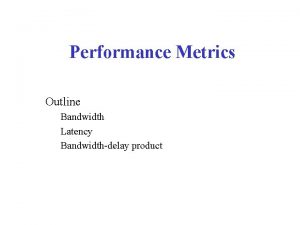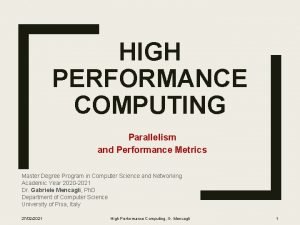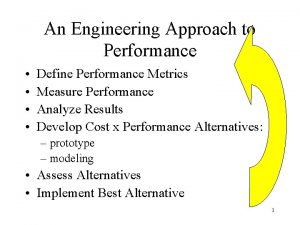Model Evaluation Metrics for Performance Evaluation How to































- Slides: 31

Model Evaluation • Metrics for Performance Evaluation – How to evaluate the performance of a model? • Methods for Performance Evaluation – How to obtain reliable estimates? • Methods for Model Comparison – How to compare the relative performance of different models?

Metrics for Performance Evaluation • Focus on the predictive capability of a model – Rather than how fast it takes to classify or build models, scalability, etc. • Confusion Matrix: PREDICTED CLASS Class=Yes ACTUAL Class=No CLASS Class=No a: TP b: FN c: FP d: TN a: TP (true positive) b: FN (false negative) c: FP (false positive) d: TN (true negative)

Metrics for Performance Evaluation… PREDICTED CLASS Class=Yes ACTUAL CLASS Class=No Class=Yes a (TP) b (FN) Class=No c (FP) d (TN) • Most widely-used metric:

Limitation of Accuracy • Consider a 2 -class problem – Number of Class 0 examples = 9990 – Number of Class 1 examples = 10 • If model predicts everything to be class 0, accuracy is 9990/10000 = 99. 9 % – Accuracy is misleading because model does not detect any class 1 example

Cost Matrix PREDICTED CLASS C(i|j) Class=Yes ACTUAL CLASS Class=No Class=Yes Class=No C(Yes|Yes) C(No|Yes) C(Yes|No) C(No|No) C(i|j): Cost of misclassifying class j example as class i

Computing Cost of Classification Cost Matrix ACTUAL CLASS Model M 1 ACTUAL CLASS PREDICTED CLASS + - + 150 40 - 60 250 Accuracy = 80% Cost = 3910 PREDICTED CLASS C(i|j) + -1 100 - 1 0 Model M 2 ACTUAL CLASS PREDICTED CLASS + - + 250 45 - 5 200 Accuracy = 90% Cost = 4255

Cost vs Accuracy Count PREDICTED CLASS Class=Yes ACTUAL CLASS Class=No Class=Yes a b Class=No c d Accuracy is proportional to cost if 1. C(Yes|No)=C(No|Yes) = q 2. C(Yes|Yes)=C(No|No) = p N=a+b+c+d Accuracy = (a + d)/N Cost PREDICTED CLASS Class=Yes ACTUAL CLASS Class=No p q Class=No q p Cost = p (a + d) + q (b + c) = p (a + d) + q (N – a – d) = q N – (q – p)(a + d) = N [q – (q-p) Accuracy]

Cost-Sensitive Measures l l l Precision is biased towards C(Yes|Yes) & C(Yes|No) Recall is biased towards C(Yes|Yes) & C(No|Yes) F-measure is biased towards all except C(No|No)

Model Evaluation • Metrics for Performance Evaluation – How to evaluate the performance of a model? • Methods for Performance Evaluation – How to obtain reliable estimates? • Methods for Model Comparison – How to compare the relative performance of different models?

Methods for Performance Evaluation • How to obtain a reliable estimate of performance? • Performance of a model may depend on other factors besides the learning algorithm: – Class distribution – Cost of misclassification – Size of training and test sets

Learning Curve l Learning curve shows how accuracy changes with varying sample size l Requires a sampling schedule for creating learning curve Effect of small sample size: - Bias in the estimate - Variance of estimate

Methods of Estimation • Holdout – Reserve 2/3 for training and 1/3 for testing • Random subsampling – Repeated holdout • Cross validation – Partition data into k disjoint subsets – k-fold: train on k-1 partitions, test on the remaining one – Leave-one-out: k=n • Bootstrap – Sampling with replacement

Model Evaluation • Metrics for Performance Evaluation – How to evaluate the performance of a model? • Methods for Performance Evaluation – How to obtain reliable estimates? • Methods for Model Comparison – How to compare the relative performance of different models?

ROC (Receiver Operating Characteristic) • Developed in 1950 s for signal detection theory to analyze noisy signals – Characterize the trade-off between positive hits and false alarms • ROC curve plots TPR (on the y-axis) against FPR (on the x-axis) PREDICTED CLASS Yes Actual No Yes a (TP) b (FN) No c (FP) d (TN)

ROC (Receiver Operating Characteristic) • Performance of each classifier represented as a point on the ROC curve – changing the threshold of algorithm, sample distribution or cost matrix changes the location of the point

ROC Curve - 1 -dimensional data set containing 2 classes (positive and negative) - any points located at x > t is classified as positive At threshold t: TP=0. 5, FN=0. 5, FP=0. 12, FN=0. 88

ROC Curve (TP, FP): • (0, 0): declare everything to be negative class • (1, 1): declare everything to be positive class • (1, 0): ideal • Diagonal line: – Random guessing – Below diagonal line: • prediction is opposite of the true class PREDICTED CLASS Yes Actual No Yes a (TP) b (FN) No c (FP) d (TN)

Using ROC for Model Comparison l No model consistently outperform the other l M 1 is better for small FPR l M 2 is better for large FPR l Area Under the ROC curve l Ideal: Area = 1 l Random guess: § Area = 0. 5

How to Construct an ROC curve Instance P(+|A) True Class 1 0. 95 + 2 0. 93 + 3 0. 87 - 4 0. 85 - 5 0. 85 - 6 0. 85 + 7 0. 76 - 8 0. 53 + 9 0. 43 - 10 0. 25 + • Use classifier that produces posterior probability for each test instance P(+|A) • Sort the instances according to P(+|A) in decreasing order • Apply threshold at each unique value of P(+|A) • Count the number of TP, FP, TN, FN at each threshold • TP rate, TPR = TP/(TP+FN) • FP rate, FPR = FP/(FP + TN)

How to construct an ROC curve Threshold >= ROC Curve:

Ensemble Methods • Construct a set of classifiers from the training data • Predict class label of previously unseen records by aggregating predictions made by multiple classifiers

General Idea

Why does it work? • Suppose there are 25 base classifiers – Each classifier has error rate, = 0. 35 – Assume classifiers are independent – Probability that the ensemble classifier makes a wrong prediction:

Examples of Ensemble Methods • How to generate an ensemble of classifiers? – Bagging – Boosting

Bagging • Sampling with replacement • Build classifier on each bootstrap sample • Each sample has probability (1 – 1/n)n of being selected

Boosting • An iterative procedure to adaptively change distribution of training data by focusing more on previously misclassified records – Initially, all N records are assigned equal weights – Unlike bagging, weights may change at the end of boosting round

Boosting • Records that are wrongly classified will have their weights increased • Records that are classified correctly will have their weights decreased • Example 4 is hard to classify • Its weight is increased, therefore it is more likely to be chosen again in subsequent rounds

Example: Ada. Boost • Base classifiers: C 1, C 2, …, CT • Data pairs: (xi, yi) • Error rate: • Importance of a classifier:

Example: Ada. Boost • Classification: • Weight update for every iteration t and classifier j : • If any intermediate rounds produce error rate higher than 50%, the weights are reverted back to 1/n

Illustrating Ada. Boost Initial weights for each data point Data points for training

Illustrating Ada. Boost
 Model evaluation metrics
Model evaluation metrics Intranet performance metrics
Intranet performance metrics Key performance indicators sample format
Key performance indicators sample format Infrastructure performance metrics
Infrastructure performance metrics Aviation performance metrics
Aviation performance metrics Engineering performance metrics
Engineering performance metrics Performance metrics for mutual exclusion algorithm
Performance metrics for mutual exclusion algorithm Characteristics of good performance metrics
Characteristics of good performance metrics Cache performance metrics
Cache performance metrics Lo performance metrics
Lo performance metrics Engineering performance metrics
Engineering performance metrics Treasury key performance indicators
Treasury key performance indicators Introscope monitoring tool
Introscope monitoring tool Computer performance metrics
Computer performance metrics Performance metrics for parallel systems
Performance metrics for parallel systems Engineering performance metrics
Engineering performance metrics Chapter 2
Chapter 2 Strategic e-marketing and performance metrics
Strategic e-marketing and performance metrics Performance metrics in computer networks
Performance metrics in computer networks Performance metrics in computer networks
Performance metrics in computer networks Router node
Router node Cache performance metrics
Cache performance metrics Boardroom metrics ceo evaluation
Boardroom metrics ceo evaluation Stronge leader effectiveness performance evaluation model
Stronge leader effectiveness performance evaluation model Performance evaluation model
Performance evaluation model Lean canvas ash maurya
Lean canvas ash maurya Lean stack canvas
Lean stack canvas Kontinuitetshantering
Kontinuitetshantering Typiska novell drag
Typiska novell drag Tack för att ni lyssnade bild
Tack för att ni lyssnade bild Ekologiskt fotavtryck
Ekologiskt fotavtryck Varför kallas perioden 1918-1939 för mellankrigstiden
Varför kallas perioden 1918-1939 för mellankrigstiden
